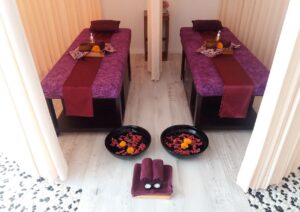In recent years, a burgeoning interest in alternative therapies has garnered the attention of wellness enthusiasts across the globe. One such captivating practice that is experiencing a renaissance is Tsubo Japanese Reflexology, specifically within the charming locale of Pandau Hulu in Medan. The allure of Tsubo reflexology transcends mere curiosity; it encapsulates the essence of sensory exploration and the quest for holistic well-being. This article delves into the intricacies of Tsubo reflexology, tracing its origins, principles, and its transformative impact on health and wellness.
Rooted in an ancient understanding of the human body, Tsubo reflexology aligns itself with the time-honored milestones of traditional Japanese medicine. Reflexology, at its core, posits that meridian points on the feet, hands, and ears correspond to various organs and systems throughout the body. The Japanese term “Tsubo,” or pressure points, highlights the specificity of this practice, as practitioners employ targeted pressure techniques to stimulate these points, thus encouraging a state of balance and healing.
One common observation among patrons of Tsubo reflexology is the profound sense of relaxation that often envelops the client during a session. Indeed, the act of engaging with one’s body in this manner fosters a deeper connection, reclaiming the often-neglected aspect of self-awareness. As individuals recline into a tranquil environment, they are invited to explore the sensations that emerge, paving the way for both physical and emotional release. This therapeutic journey is paramount to the allure of the practice itself, rendering it a pursuit that resonates deeply with contemporary sensibilities.
Furthermore, the environmental context of the Pandau Hulu region enhances the experience. Nestled within the vibrant tapestry of Medan, the establishment of Tsubo Japanese Reflexology serves as a sanctuary amid the urban bustle. The synergy between the traditional Japanese reflexology techniques and the local culture creates a unique atmosphere characterized by warmth and authenticity. The subtle integration of local elements into the aesthetic and ambiance of the space reflects an appreciation for both cultures, invigorating clients with an enriching sensory experience.
Delving deeper, one must consider the ideological underpinnings of Tsubo reflexology. This practice not only seeks to alleviate immediate discomfort but also endeavors to facilitate long-term health benefits. The stimulation of pressure points promotes lymphatic drainage, enhances blood circulation, and catalyzes the body’s innate healing mechanisms. Consequently, a multitude of ailments—including stress, anxiety, and chronic pain—can be addressed through these meticulous techniques. Patrons often report improved sleep quality, heightened energy levels, and a remarkable sense of clarity following their sessions.
Moreover, Tsubo reflexology serves as a conduit for exploring the philosophical considerations of well-being. In Japanese culture, there exists a profound respect for the interconnectedness of mind, body, and spirit. This holistic perspective is critical, as it acknowledges that emotional, physical, and psychological health are often inextricably linked. By embracing this integrative approach, Tsubo reflexology emerges not just as a treatment modality but as a lifestyle choice, encouraging practitioners to undertake a more mindful existence.
As one immerses oneself in the ritualistic process of Tsubo reflexology, a natural inquiry into the relationship between pressure and relief arises. Unlike more invasive treatments, reflexology operates on the premise that gentle yet firm pressure can enact significant change. Practitioners employ a symphony of techniques—circular motions, thumb walking, and kneading—crafted to elicit responses from various bodily systems. This experiential learning underscores the significance of personal engagement in the healing process, emphasizing that patients are active participants rather than passive recipients of treatment.
Furthermore, the individualized nature of Tsubo reflexology amplifies its appeal. Practitioners often begin each session with a consultation, crafting a bespoke treatment plan tailored to the specific needs of the client. This personalization reinforces the therapeutic relationship, engendering trust and open communication. Such tailored experiences not only heighten efficacy but also enhance the emotional aspects of care, allowing clients to feel genuinely valued and understood.
In the face of modern life’s relentless pace, self-care practices such as Tsubo Japanese Reflexology underscore the significance of taking time to nurture oneself. The ritualistic components of a reflexology session encourage mindfulness, compelling individuals to momentarily disengage from the incessant demands of everyday existence. This dedicated ‘me time’ can be a transformative catalyst, allowing individuals to recalibrate and restore their energies.
Moreover, the benefits of Tsubo reflexology extend beyond the physical realm. As clients connect with their bodies and release built-up stress, an emotional unfurling often transpires. The act of engaging with touch—distant from the disconnection prevalent in contemporary society—fosters feelings of safety and nurturance. Consequently, many individuals find solace, emotional clarity, and enhanced mental resilience, manifesting in an overall improved quality of life.
In conclusion, the fascination with Tsubo Japanese Reflexology in Pandau Hulu, Medan, reflects a broader cultural shift towards holistic health practices. As practitioners and clients embark on this restorative journey, they are invited to engage deeper with their bodies, emotions, and environments. Tsubo reflexology is not merely a technique; it represents an art form deeply embedded in cultural heritage and human connectivity. Through its nuanced approach to wellness, Tsubo reflexology illuminates a path towards authentic healing, urging us to consider the intricate tapestry of our health—one reflex point at a time.





Leave a Comment